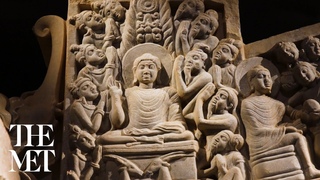Symposium—Tree & Serpent: Early Buddhist Art in India and Its Global Reach, Day 1
Join an international group of scholars for a two-day symposium presenting new scholarship around the themes explored in the exhibition Tree & Serpent: Early Buddhist Art in India, 200 BCE–400 CE. The keynote lecture is presented by Gregory Schopen, Distinguished Professor Emeritus of Asian Languages and Cultures at the University of California, Los Angeles.
Welcoming Remarks
10:30–10:45 am
Andrea Bayer, Deputy Director for Collections and Administration, The Met
Randhir Jaiswal, Consul General of India in New York
Symposium Introduction
John Guy, Florence and Herbert Irving Curator of the Arts of South and Southeast Asian Art, The Met
Session One: Origins of Buddhist Art in India
10:45 am–1 pm
Chair: Akira Shimada, Professor of History, State University of New York, New Paltz
The Nāga Cult and a Reassessment of Imagery at the Nasik Caves
Robert DeCaroli, Professor of Art History, George Mason University
Sopara, Kanheri, and the Early Buddhist Landscape on the West Coast of India
Pia Brancaccio, Professor of Art History, Drexel University
Imperial Representations: Spotting Aśoka at Buddhist Sanchi
Nayanjot Lahiri, Professor of History, Ashoka University
The Discovery at Piprahwa and Its Afterlife
Chris Peppé, independent scholar
Discussion
Moderated by Akira Shimada
Break and Exhibition Viewing
1–2:30 pm
Session Two: Southern Buddhism of Āndhradeśa
2:30–4:30 pm
Chair: Stefan Baums, Institute of Indology and Tibetology, Ludwig Maximilian University, Munich
Arhats in the Religious Landscape of Āndhradeśa: A Devalued Ideal?
Vincent Tournier, Chair of Classical Indology, Institute of Indology and Tibetology, Ludwig Maximilian University, Munich
Towards a Corpus of Inscriptions of Early Historic Āndhradeśa
Arlo Griffiths, Professor of Southeast Asian History, Head of the Jakarta Center, École française d’Extrême-Orient
Buddhist Art and Coins: Numismatic Underpinnings and the Deccan, ca. 200 BCE–400 CE
Shailendra Bhandare, Senior Assistant Keeper, Ashmolean Museum, University of Oxford
Discussion
Moderated by Stefan Baums
Stretch Break
4:30–5 pm
Keynote Lecture
5–5:45 pm
Not Very Far from the Madding Crowd: Ordinary Life in an Indian Buddhist Monastery
Gregory Schopen, Distinguished Professor Emeritus of Asian Languages and Cultures, University of California, Los Angeles
Respondent: Vincent Tournier
Presented in conjunction with the exhibition Tree & Serpent: Early Buddhist Art in India, 200 BCE–400 CE.
This symposium is made possible by the Fred Eychaner Fund.
Organized by The Met in cooperation with NYU Center for Global Asia, NYU Shanghai Center for Global Asia, and the Lakshmi Mittal and Family South Asia Institute, Harvard University.
Image: Ayaka cornice with three narrative scenes (detail). 3rd century CE. India, Nagarjunakonda, Gunter District, Andhra Pradesh. Limestone. Overall: H. 16 1/8 in. (41 cm); W. 58 1/4 in. (148 cm); D. 8 1/4 in. (21 cm); DSR est. weight 485.2 lbs. (220.1 kg); Star est. weight 518.1 lbs. (235 kg). Lent by the Archaeological Museum, ASI, Nagarjunakonda, Andhra Pradesh (46)
--
Subscribe for new content from The Met:
#TheMet #Art #TheMetropolitanMuseumofArt #Museum
© 2023 The Metropolitan Museum of Art























